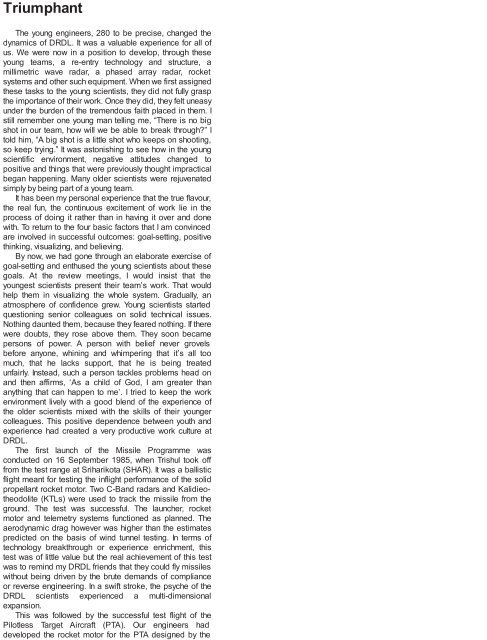wings-of-fire-by-abdul-kalam-printers1
Create successful ePaper yourself
Turn your PDF publications into a flip-book with our unique Google optimized e-Paper software.
Triumphant<br />
The young engineers, 280 to be precise, changed the<br />
dynamics <strong>of</strong> DRDL. It was a valuable experience for all <strong>of</strong><br />
us. We were now in a position to develop, through these<br />
young teams, a re-entry technology and structure, a<br />
millimetric wave radar, a phased array radar, rocket<br />
systems and other such equipment. When we first assigned<br />
these tasks to the young scientists, they did not fully grasp<br />
the importance <strong>of</strong> their work. Once they did, they felt uneasy<br />
under the burden <strong>of</strong> the tremendous faith placed in them. I<br />
still remember one young man telling me, “There is no big<br />
shot in our team, how will we be able to break through?” I<br />
told him, “A big shot is a little shot who keeps on shooting,<br />
so keep trying.” It was astonishing to see how in the young<br />
scientific environment, negative attitudes changed to<br />
positive and things that were previously thought impractical<br />
began happening. Many older scientists were rejuvenated<br />
simply <strong>by</strong> being part <strong>of</strong> a young team.<br />
It has been my personal experience that the true flavour,<br />
the real fun, the continuous excitement <strong>of</strong> work lie in the<br />
process <strong>of</strong> doing it rather than in having it over and done<br />
with. To return to the four basic factors that I am convinced<br />
are involved in successful outcomes: goal-setting, positive<br />
thinking, visualizing, and believing.<br />
By now, we had gone through an elaborate exercise <strong>of</strong><br />
goal-setting and enthused the young scientists about these<br />
goals. At the review meetings, I would insist that the<br />
youngest scientists present their team’s work. That would<br />
help them in visualizing the whole system. Gradually, an<br />
atmosphere <strong>of</strong> confidence grew. Young scientists started<br />
questioning senior colleagues on solid technical issues.<br />
Nothing daunted them, because they feared nothing. If there<br />
were doubts, they rose above them. They soon became<br />
persons <strong>of</strong> power. A person with belief never grovels<br />
before anyone, whining and whimpering that it’s all too<br />
much, that he lacks support, that he is being treated<br />
unfairly. Instead, such a person tackles problems head on<br />
and then affirms, ‘As a child <strong>of</strong> God, I am greater than<br />
anything that can happen to me’. I tried to keep the work<br />
environment lively with a good blend <strong>of</strong> the experience <strong>of</strong><br />
the older scientists mixed with the skills <strong>of</strong> their younger<br />
colleagues. This positive dependence between youth and<br />
experience had created a very productive work culture at<br />
DRDL.<br />
The first launch <strong>of</strong> the Missile Programme was<br />
conducted on 16 September 1985, when Trishul took <strong>of</strong>f<br />
from the test range at Sriharikota (SHAR). It was a ballistic<br />
flight meant for testing the inflight performance <strong>of</strong> the solid<br />
propellant rocket motor. Two C-Band radars and Kalidieotheodolite<br />
(KTLs) were used to track the missile from the<br />
ground. The test was successful. The launcher, rocket<br />
motor and telemetry systems functioned as planned. The<br />
aerodynamic drag however was higher than the estimates<br />
predicted on the basis <strong>of</strong> wind tunnel testing. In terms <strong>of</strong><br />
technology breakthrough or experience enrichment, this<br />
test was <strong>of</strong> little value but the real achievement <strong>of</strong> this test<br />
was to remind my DRDL friends that they could fly missiles<br />
without being driven <strong>by</strong> the brute demands <strong>of</strong> compliance<br />
or reverse engineering. In a swift stroke, the psyche <strong>of</strong> the<br />
DRDL scientists experienced a multi-dimensional<br />
expansion.<br />
This was followed <strong>by</strong> the successful test flight <strong>of</strong> the<br />
Pilotless Target Aircraft (PTA). Our engineers had<br />
developed the rocket motor for the PTA designed <strong>by</strong> the


